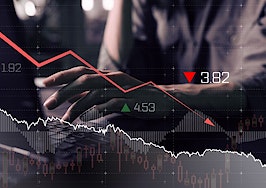At Inman Connect Las Vegas, July 30-Aug. 1, 2024, the noise and misinformation will be banished, all your big questions will be answered, and new business opportunities will be revealed. Join us.
Some of homeownership’s largest hidden costs, including property taxes and homeowners insurance, are the biggest factors contributing to a growing number of mortgage delinquencies, a survey from Auction.com shows.
Hidden costs, like property taxes and homeowners insurance, were given a 37 percent risk factor for triggering mortgage delinquency by leaders in default servicing, according to the survey, making it the highest-ranked risk factor.
Consumer debt delinquencies were also ranked high at 32 percent, followed by rising unemployment at 15 percent, commercial mortgage defaults at 10 percent and falling home prices at 6 percent.
Auction.com’s survey was conducted in April. Respondents included banks, nonbanks, mortgage asset owners and investors, government agencies and government-sponsored enterprises.

Insurance costs have surged in many parts of the country in recent years, even as major insurance companies have pulled out of what are seen as high-risk states, like California and Florida.
Homeowners’ insurance costs nationally rose 33.8 percent from 2018 through 2023, according to S&P Global Market Intelligence. In Texas, rates jumped 60 percent during that period, while rates rose more than 50 percent across Colorado, Arizona and Utah.
Climate change and the risk associated with it has been a major factor contributing to rising costs, Benjamin Collier, an associate professor of risk management and insurance at Temple University, told Realtor.com.
“A major reason is climate risk, and that insurers have had broad losses from severe climate events over the past few years from hurricanes and severe storms,” Collier said. “If you look at places where insurers have been paying out more claims than taking in premiums over the last couple years, it’s half the states.”
Inflation in construction costs has also added to rising insurance premiums, Collier noted. But, more near-term, higher insurance rates are more likely to affect mortgage delinquencies in regions that have seen an uptick in climate-related events in recent years, he said.
“My expectation is that these challenges would be greatest in higher-risk areas, because those higher-risk areas are where we’re seeing insurance prices climb the fastest,” Collier told Realtor.com. “I also think that this problem might be greater for lower-income households in those areas, who are often living and working much closer to the edge of their available budget.”
On top of rising home insurance costs, many homeowners are also dealing with rising property taxes as a result of surging home values. Last year, the average tax on single-family homes in the U.S. rose 4.1 percent to $4,062, after a 3 percent increase the year before, a report from Attom Data Solutions shows.
The hidden costs of owning and maintaining a single-family home in the U.S. now average more than $18,000 per year, according to Bankrate. That figure translates to about $1,500 per month on top of a mortgage payment, up 26 percent from four years ago.
That’s a lot of additional costs for homeowners, especially for established homeowners who have been accustomed to lower costs during their tenure.
Foreclosure rates remain relatively low
Foreclosure activity has remained relatively low in the U.S., according to Attom, with 177,431 U.S. properties receiving foreclosure filings (including default notices, scheduled auctions or bank repossessions) during the first half of 2024. During the 2008 housing recession, about 15 times as many borrowers faced foreclosure. That figure from the first half of 2024 is also 4.4 percent less than what it was during the first half of 2023.
“Given the low default environment we’re in, this finding serves as an early warning of what could trigger more defaults in the future, especially if we continue to see more natural disaster events that, in turn, put more upward pressure on home insurance rates,” Daren Blomquist, a vice president of market economics at Auction.com, told Realtor.com.
“It’s important to note that even though rising hidden homeownership costs represented the highest risk factor of rising defaults, the majority of our mortgage servicing survey respondents believe that foreclosure volume will rise only modestly for the rest of the year (less than 5 percent),” Blomquist continued. “So these rising hidden homeownership costs represent the highest risk in a low-risk environment.”
If foreclosure rates do start to rise, they may begin in areas where those hidden costs are increasing the most quickly, Auction.com’s survey suggested.
For instance, foreclosure starts surpassed pre-pandemic levels in May in areas of the Gulf Coast, Texas and inland California, according to Blomquist — all areas that have seen storm and wildfire damage in recent years.
Foreclosure starts hit 135 percent of pre-pandemic levels in Houston, Texas; 93 percent of pre-pandemic levels in Riverside-San Bernadino, California; 100 percent of pre-pandemic levels in Tampa-St. Petersburg, Florida; 114 percent of pre-pandemic levels in Orlando, Florida; and 104 percent of pre-pandemic levels in San Antonio, Texas.
Those markets are located in states that are among the top 10 for insurance premium increases between 2018 and 2023, according to Attom’s data.
“Although it’s too early to fully connect the dots, we do see more rapidly rising foreclosure starts in many of the major markets where insurance costs have been rising,” Blomquist said.
“Absent of broader economic or housing market shocks, we would expect the default trend to follow the uneven regional pattern,” he added. “Markets with higher and faster-rising hidden homeownership costs would likely see a bigger increase in defaults. We are already seeing some signs this could be playing out when we look at recent foreclosure start data.”













